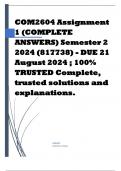COM2604 Assignment
1 (COMPLETE
ANSWERS) Semester 2
2024 (817738) - DUE 21
August 2024 ; 100%
TRUSTED Complete,
trusted solutions and
explanations.
ADMIN
[COMPANY NAME]
,QUESTION 1 STUDY UNIT 3 Approaches to the study of mass
communication When we attempt to describe, interpret, evaluate
and predict a phenomenon, in this case mass communication,
understanding said phenomenon is key. Various factors influence
this. 1.1 In a short paragraph, present a well-formulated definition
of mass communication using your own examples to substantiate
your answer. (5) 1.2 Further to the above, there are various
perspectives on mass communication. Briefly mention each of
these and their specific emphasis. (5) 1.3 The theoretical approach
you use also holds certain implications for your understanding of
mass communication. Briefly discuss the main characteristics of
the two approaches listed below: 1.3.1 The technological
determinism approach. (5) 1.3.2 The poststructionalist/postmodern
approach. (5) [TOTAL 20]
Question 1.1: Definition of Mass Communication
Mass Communication: Mass communication is the process of
transmitting information, ideas, attitudes, or emotions from a
source to a large, diverse audience through various media
channels. It involves the use of technology to disseminate
messages widely and efficiently.
Example: An example of mass communication is a news
broadcast on television. The news anchor presents information
about current events to millions of viewers simultaneously.
Another example is a viral social media post where an individual’s
message or video reaches a global audience within minutes.
Question 1.2: Perspectives on Mass Communication
, 1. Functionalist Perspective:
o Emphasis: This perspective views mass
communication as serving essential functions in society,
such as providing information, entertainment, and
socialization. It focuses on how media content helps
maintain social stability and cohesion.
2. Critical Perspective:
o Emphasis: The critical perspective emphasizes the
power dynamics and inequalities within mass
communication. It examines how media can reinforce
dominant ideologies and perpetuate social inequalities.
3. Cultural Perspective:
o Emphasis: This perspective focuses on the cultural
aspects of mass communication, exploring how media
content reflects and shapes cultural norms, values, and
identities.
4. Feminist Perspective:
o Emphasis: The feminist perspective analyzes how mass
communication portrays gender roles and identities. It
critiques the representation of women and other
marginalized groups in media and advocates for more
equitable portrayals.
5. Audience Perspective:
o Emphasis: This perspective emphasizes the role of the
audience in interpreting and responding to media
content. It explores how different audiences make sense
of media messages and the active role they play in
creating meaning.
Question 1.3: Theoretical Approaches to Mass
Communication




